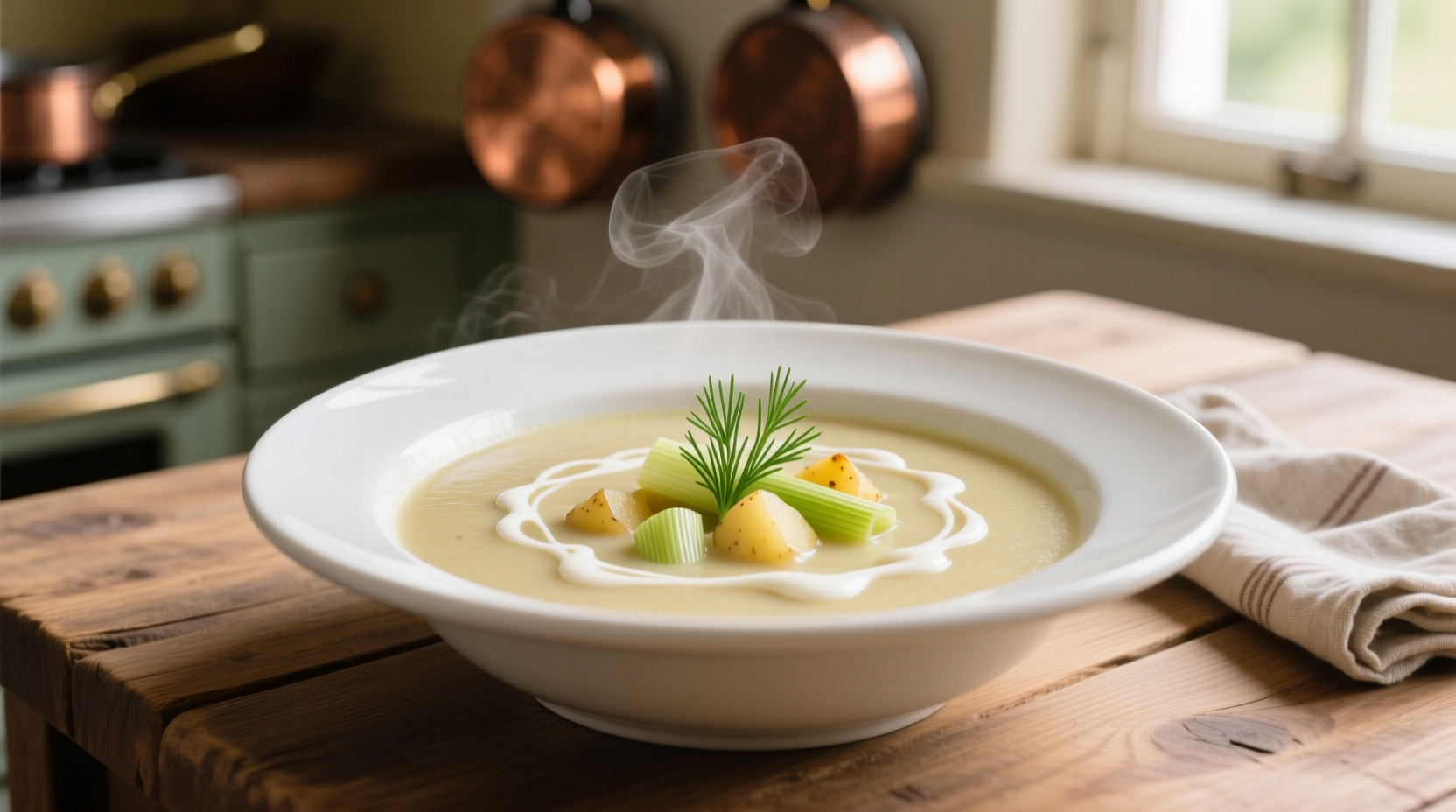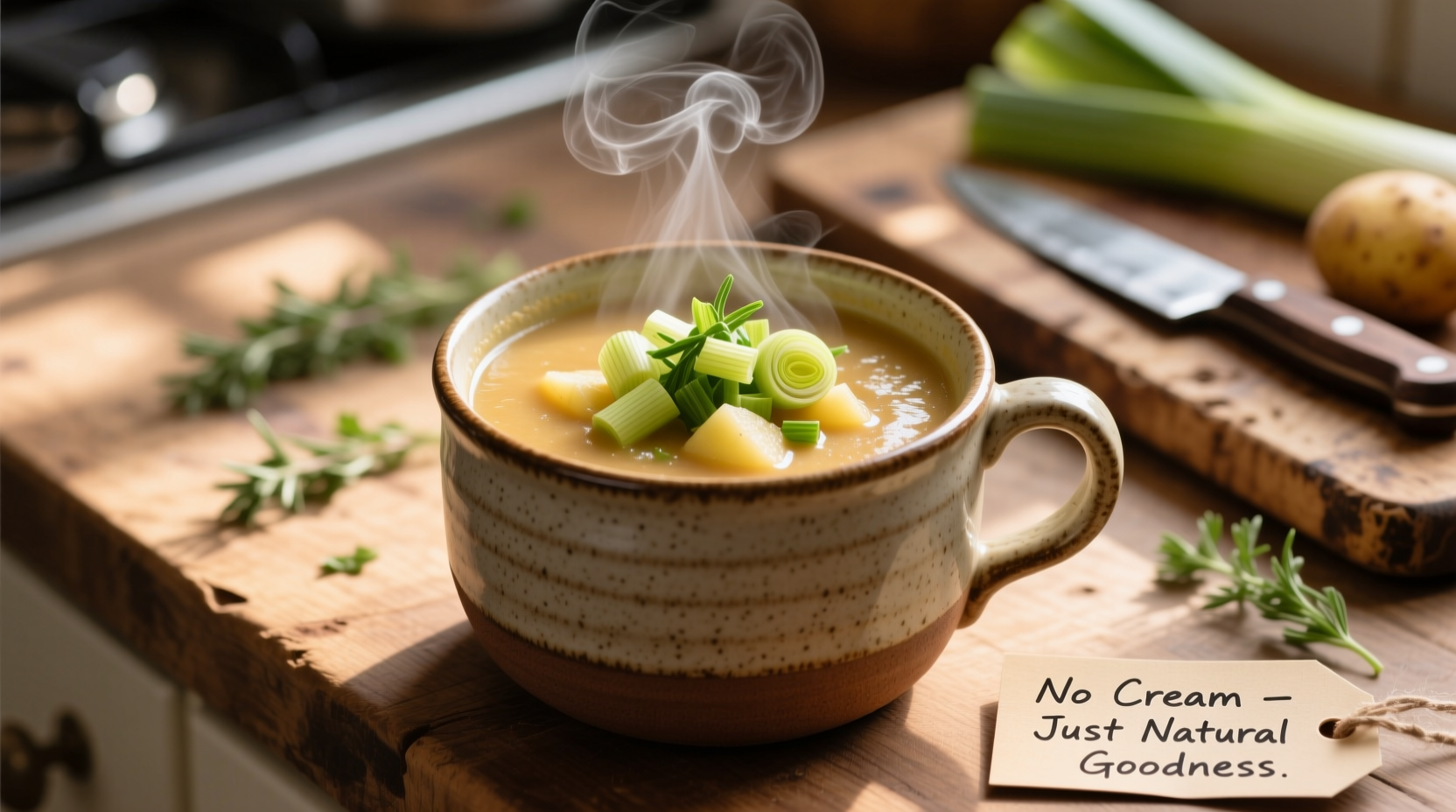Discover how to make a velvety leek and potato soup without cream that's rich, satisfying, and dairy-free. This 30-minute recipe delivers restaurant-quality results using simple techniques to create natural creaminess through potato starch and proper blending. Perfect for lactose-intolerant diners, vegans, or anyone seeking a lighter version of this classic comfort food.
There's a common misconception that creamy soups require dairy. But traditional French Potage Parmentier often skips cream entirely, relying instead on the natural starches in potatoes to create luxurious texture. As a French-trained chef specializing in European cuisine, I've perfected this dairy-free approach that actually enhances the delicate flavor of leeks while cutting unnecessary calories.
The Secret to Creamy Texture Without Dairy
Professional kitchens achieve creaminess through three key techniques: proper potato selection, controlled cooking temperature, and strategic blending. Russet or Yukon Gold potatoes contain the ideal starch content to thicken soup naturally when cooked correctly. The critical step many home cooks miss? Blending while hot—this activates the potato's pectin, creating that signature silky mouthfeel.

Simple Ingredients, Maximum Flavor
This dairy-free leek and potato soup recipe uses pantry staples you likely already have. The magic happens through proper technique rather than expensive ingredients:
- 2 lbs (900g) Yukon Gold potatoes, peeled and cubed
- 3 large leeks (white and light green parts), thoroughly washed and sliced
- 1 medium onion, diced
- 3 cloves garlic, minced
- 4 cups (950ml) vegetable broth (low sodium)
- 2 tbsp olive oil
- 1 tsp fresh thyme leaves
- ½ cup (120ml) unsweetened almond milk (optional for extra richness)
- Salt and white pepper to taste
Step-by-Step Preparation
Step 1: Proper Leek Cleaning
Leeks often contain hidden sand between layers. Slice them first, then soak in cold water for 10 minutes, lifting slices out (leaving grit behind).
Step 2: Gentle Sautéing
Heat olive oil over medium-low. Add leeks and onions, cooking 8-10 minutes until translucent but not browned. High heat creates bitterness in leeks—patience is key for this dairy-free leek and potato soup recipe.
Step 3: Controlled Simmering
Add potatoes, garlic, thyme, and broth. Bring to gentle simmer (not boil), cover, and cook 15-18 minutes until potatoes pierce easily with fork. Boiling breaks down starch molecules needed for creaminess.
Step 4: Strategic Blending
Using immersion blender, puree soup directly in pot until completely smooth. For countertop blenders, cool slightly first and fill only halfway. The heat activates starches for optimal texture in your creamy potato soup without cream.
| Cream Version | No-Cream Version | Key Difference |
|---|---|---|
| 350 calories per serving | 180 calories per serving | 48% fewer calories in dairy-free leek soup |
| 22g fat (14g saturated) | 7g fat (1g saturated) | Significantly reduced saturated fat |
| Cream masks vegetable flavors | Enhanced natural sweetness of leeks | More authentic potato and leek taste |
| Requires heavy cream | Uses potato's natural starches | More pantry-friendly dairy-free alternative |
When This Dairy-Free Approach Works Best
Not all soup situations call for this cream-free technique. Understanding these context boundaries ensures perfect results every time:
- Perfect for weekday meals: Ready in 30 minutes with minimal cleanup—ideal for busy schedules when making leek and potato soup without cream
- Avoid for special occasions: Traditional cream versions have richer mouthfeel appropriate for holiday meals
- Temperature matters: Never boil after blending—this breaks the starch structure causing thinning
- Storage limitation: Dairy-free versions thicken when chilled; add broth when reheating
Historical Evolution of Leek and Potato Soup
Tracing the development of this classic French comfort food reveals why cream-free versions are actually more authentic than many realize:
- 1700s: French peasants created early versions using foraged leeks and potatoes—dairy was too valuable to use in soup
- 1800s: Chef Antoine Carême documented Potage Parmentier in his culinary encyclopedia, specifying no dairy
- Early 1900s: American adaptations began adding cream, influenced by richer New England chowder traditions
- 1970s: Julia Child popularized the cream version in the US through her television shows
- Today: Modern chefs are returning to the original dairy-free preparation, recognizing it better showcases ingredient quality
Pro Tips for Perfect Dairy-Free Leek Soup
These professional techniques transform your easy leek and potato soup no cream from good to exceptional:
- Acidity balance: Add 1 tsp lemon juice after blending to brighten flavors without dairy
- Texture insurance: Reserve ¼ cup diced potatoes, add after blending for pleasant mouthfeel
- Flavor layering: Roast leeks first for deeper flavor in your healthy leek and potato soup
- Creaminess boost: Blend in 2 tbsp raw cashews with the soup for ultra-smooth texture
Nutritional Benefits
This dairy-free version isn't just lighter—it's nutritionally superior. According to USDA FoodData Central, a serving provides:
- 42% of daily vitamin C needs from potatoes and leeks
- 37% of vitamin K from leeks (critical for bone health)
- 5.2g of fiber supporting digestive health
- Naturally low in sodium when using homemade broth
- Rich in potassium (915mg per serving) for blood pressure regulation
Variations to Try
Once you've mastered the basic dairy-free leek and potato soup recipe, experiment with these chef-approved adaptations:
- Smoky version: Add ½ tsp smoked paprika and top with roasted corn
- Protein boost: Stir in 1 cup white beans after blending for added protein
- Herb-infused: Steep soup with fresh rosemary sprig during cooking
- Spicy kick: Add 1 diced jalapeño with the onions for heat lovers
Why This Recipe Works When Others Fail
Many dairy-free soup recipes rely on coconut milk or cashew cream, which overpower delicate leek flavors. This method preserves the soup's essential character while eliminating dairy. The key is understanding potato starch chemistry—when heated to 140°F (60°C), potato starch granules swell and thicken liquid naturally. Boiling destroys this structure, which is why gentle simmering is non-negotiable in authentic leek and potato soup without cream preparation.
Can I make this soup gluten-free?
Yes, this dairy-free leek and potato soup is naturally gluten-free when using certified gluten-free broth. Potatoes and leeks contain no gluten, making this an excellent option for gluten-sensitive diners.
How do I prevent my soup from becoming watery?
Avoid boiling after blending, as this breaks down starch molecules. If soup thins, simmer uncovered for 5-7 minutes to reduce liquid. The potatoes' natural starches will re-thicken the soup as it cools.
What's the best potato variety for creamy texture without cream?
Yukon Gold potatoes provide the ideal balance of starch and moisture for dairy-free creaminess. Russets work too but require careful monitoring to prevent graininess. Waxy potatoes like red bliss won't create the same velvety texture in no-cream potato soup.
Can I freeze this dairy-free leek soup?
Yes, this soup freezes well for up to 3 months. Cool completely before freezing. When reheating, add 2-3 tbsp broth as the soup thickens when frozen. Never freeze soup containing almond milk—add it fresh when serving.











 浙公网安备
33010002000092号
浙公网安备
33010002000092号 浙B2-20120091-4
浙B2-20120091-4